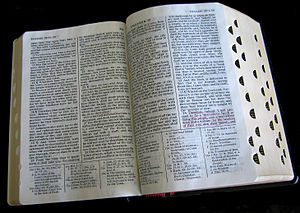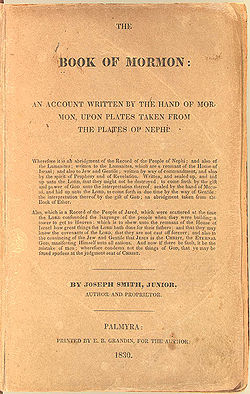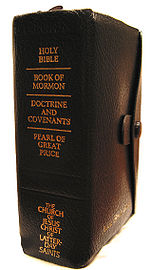- Standard Works
-
The Standard Works of The Church of Jesus Christ of Latter-day Saints (LDS Church) are the four books that currently constitute its open scriptural canon.
- The Holy Bible (King James version)[1]
- The Book of Mormon: Another Testament of Jesus Christ
- The Doctrine and Covenants of The Church of Jesus Christ of Latter-day Saints
- The Pearl of Great Price
The Standard Works are printed and distributed by the LDS church in a single binding called a Quadruple Combination and as a set of two books, with the Bible in one binding, and the other three books in a second binding called a Triple Combination. Current editions of the standard works include a bible dictionary, photographs, maps and gazetteer, topical guide, index, footnotes, cross references, excerpts from the Joseph Smith Translation of the Bible (JST), and other study aids.
Contents
Continuing revelation
Under the Church's doctrine of continuing revelation (see the Ninth Article of Faith), Latter-day Saints believe literally in the principle of revelation from God to his children. Individual members are entitled to divine revelation for confirmation of truths, gaining knowledge or wisdom, meeting personal challenges, etc. Parents are entitled to revelation for raising their families.
Divine revelation for the direction of the entire Church comes from God to the President of the Church, who is viewed by Latter-day Saints as a prophet in the same sense as Noah, Abraham, Moses, Peter, and other biblical leaders. When prophets and General Authorities of the Church speak as "moved upon by the Holy Ghost", ...shall be scripture, shall be the will of the Lord, shall be the mind of the Lord, shall be the word of the Lord, shall be the voice of the Lord, and the power of God unto salvation.(Doctrine & Covenants 68:4). Members are encouraged to ponder these revelations and pray to determine for themselves the truthfulness of doctrine.
Adding to the canon of scripture
The Doctrine and Covenants teaches that "all things must be done in order, and by common consent in the church."(D&C 28:13). This applies to adding new scripture. President of the Church Harold B. Lee taught "The only one authorized to bring forth any new doctrine is the President of the Church, who, when he does, will declare it as revelation from God, and it will be so accepted by the Council of the Twelve and sustained by the body of the Church."[2] There are six recorded instances of this happening in the LDS church:
- April 6, 1830 - When the church was organized, the Bible and Book of Mormon were unanimously accepted as scripture.[citation needed]
- August 17, 1835 - Select revelations from Joseph Smith were unanimously accepted as scripture.[3] These were later printed in the Doctrine and Covenants.
- October 10, 1880 - The Pearl of Great Price was unanimously accepted as scripture.[4] Also at that time, other revelations in the Doctrine and Covenants which had not been accepted as scripture because they were received after 1835 were unanimously accepted as scripture.[5]
- October 6, 1890 - Official Declaration—1 was accepted unanimously as scripture.[6]
- April 3, 1976 - Two visions were accepted as scripture and initially added to The Pearl of Great Price, and later moved to the Doctrine and Covenants as sections 137 and 138.[7]
- September 30, 1978 - Official Declaration—2 was accepted unanimously as scripture.[8]
When a doctrine undergoes this procedure, the LDS Church treats it as the word of God, and it is used as a standard to compare other doctrines. Lee taught "It is not to be thought that every word spoken by the General Authorities is inspired, or that they are moved upon by the Holy Ghost in everything they speak and write. Now you keep that in mind. I don't care what his position is, if he writes something or speaks something that goes beyond anything that you can find in the standard works, unless that one be the prophet, seer, and revelator—please note that one exception—you may immediately say, "Well, that is his own idea!" And if he says something that contradicts what is found in the standard works (I think that is why we call them "standard"—it is the standard measure of all that men teach), you may know by that same token that it is false; regardless of the position of the man who says it."[9]
 Quadruple combination opened to the Book of Isaiah - note the cross references between Biblical and Latter-day Saint scripture in the footnotes
Quadruple combination opened to the Book of Isaiah - note the cross references between Biblical and Latter-day Saint scripture in the footnotes
The Bible
See also: The Bible and LDS edition of the BibleEnglish-speaking Latter-day Saints typically own and study the LDS Church-published edition of the King James Version of the Bible, which includes LDS-oriented chapter headings, footnotes referencing books in the Standard Works, and select passages from the Joseph Smith Translation of the Bible.[10]
Though the King James Version (KJV) was always commonly used, it was officially adopted in the 1950s when J. Reuben Clark, of the First Presidency, argued extensively that newer translations, such as Revised Standard Version of 1952, were of lower quality and less compatible with LDS tradition.[11] After publishing its own edition in 1979, the First Presidency announced in 1992 that the KJV was the church's official English Bible, stating "[w]hile other Bible versions may be easier to read than the King James Version, in doctrinal matters latter-day revelation supports the King James Version in preference to other English translations."[12] In 2010 this was written into the church's Handbook, which directs official church policy and programs.[11]
A Spanish version, with a similar format and using a slightly revised version of the 1909 Reina-Valera translation, was published in 2009.[13] Latter-day Saints in other non-English speaking areas may use other versions of the Bible.
Though the Bible is part of the LDS canon and members believe it to be the word of God, they believe that omissions and mistranslations are present in even the earliest known manuscripts. They claim that the errors in the Bible have led to incorrect interpretations of certain passages. Thus, as church founder Joseph Smith, Jr. explained, the church believes the Bible to be the word of God "as far as it is translated correctly."[14] The church teaches that "[t]he most reliable way to measure the accuracy of any biblical passage is not by comparing different texts, but by comparison with the Book of Mormon and modern-day revelations".[12]
The manuscripts of the Joseph Smith Translation of the Bible state that "the Song of Solomon is not inspired scripture,"[15] and therefore it is not included in LDS canon and rarely studied by members of the LDS church. However, it is still printed in every version of the King James Bible published by the church.
The Apocrypha
Although the Apocrypha was part of the 1611 edition of the KJV, the Church does not currently use the Apocrypha as part of its canon. Joseph Smith Jr. taught that while the contemporary edition of the Apocrypha was not to be relied on for doctrine, it was potentially useful when read with a spirit of discernment.[16]
Joseph Smith Translation of the Bible
Main article: Joseph Smith Translation of the BibleJoseph Smith translated selected verses of the Bible, working by subject. Smith did not complete the entire text of the Bible during his lifetime. However, his incomplete work is known as the Joseph Smith Translation of the Bible, or the Inspired Version. Although this selected translation is not generally quoted by members of the Church, the English Bible issued by the Church and commonly used by Latter-day Saints contains cross references to the Joseph Smith Translation (JST), as well as an appendix containing major excerpts from it. However, with the exceptions of Smith's translation of portions of the book of Book of Genesis (renamed the Selections from the Book of Moses) and the translation of Matthew 23:39-24:51, no portions of the Joseph Smith Translation have been officially canonized by the LDS Church.
The Book of Mormon
 Cover page of The Book of Mormon from an original 1830 edition, by Joseph Smith, Jr.
Cover page of The Book of Mormon from an original 1830 edition, by Joseph Smith, Jr.
(Image from the U.S. Library of Congress Rare Book and Special Collections Division.)Main articles: Book of Mormon and List of Book of Mormon translationsLatter-day Saints consider The Book of Mormon as a volume of holy scripture comparable to the Bible. It contains a record of God’s dealings with the prophets and ancient inhabitants of the Americas. The introduction to the book asserts that it "contains, as does the Bible, the fullness of the everlasting gospel. The book was written by many ancient prophets by the spirit of prophecy and revelation. Their words, written on gold plates, were quoted and abridged by a prophet-historian named Mormon."
Segments of the Book of Mormon provide an account of the culture, religious teachings and civilizations of groups who immigrated to the New World. One came from Jerusalem in 600 B.C., and afterward separated into two nations, identified in the book as the Nephites and the Lamanites. Some years after their arrival, the Nephites met with a similar group, the Mulekites who left the Middle East during the same period. An older group arrived in America much earlier, when the Lord confounded the tongues at the Tower of Babel. This group is known as the Jaredites and their story is condensed in the Book of Ether. The crowning event recorded in the Book of Mormon is the personal ministry of Jesus Christ among Nephites soon after his resurrection. This account presents the doctrines of the gospel, outlines the plan of salvation, and offers men peace in this life and eternal salvation in the life to come. The latter segments of the Book of Mormon details the destruction of these civilizations, as all were destroyed except the Lamanites. The book asserts that the Lamanites are among the ancestors of the indigenous peoples of the Americas.
According to his record, Joseph Smith, Jr. translated the Book of Mormon by gift and power of God through the Urim and Thummim. Eleven witnesses signed testimonies of its authenticity, which are now included in the preface to the Book of Mormon. The Three Witnesses testified to having seen an angel present the gold plates, and to having heard God bear witness to its truth. Eight others stated that Joseph Smith, Jr. showed them the plates and that they handled and examined them.
The Doctrine and Covenants
The Doctrine and Covenants of The Church of Jesus Christ of Latter-day Saints is a collection of revelations, policies, letters, and statements given to the modern Church by past Presidents of the Church. This record contains points of Church doctrine and direction on Church government. The book has existed in numerous forms, with varying content, throughout the history of the Church and has also been published in differing formats by the various Latter Day Saint denominations. When the Church chooses to canonize new material, it is typically added to the Doctrine and Covenants; the most recent changes were made in 1981.
The Pearl of Great Price
The Pearl of Great Price is a selection of material produced by Joseph Smith, Jr. and deals with many significant aspects of the faith and doctrine of the Church. Many of these materials were initially published in Church periodicals in the early days of church.
The Pearl of Great Price contains five sections:
- Selections from the Book of Moses: portions of the Book of Genesis from the Joseph Smith Translation of the Bible.
- The Book of Abraham: a translation from papyri acquired by Smith in 1835, dealing with Abraham's journeys in Egypt. The work contains many distinctive Mormon doctrines such as exaltation.
- Joseph Smith—Matthew: portions of the Gospel of Matthew from the Joseph Smith Translation of the Bible.
- Joseph Smith—History: a first-person narrative of Joseph Smith's life before the founding of the Church. The material is taken from Documentary History of the Church and is based on a history written by Smith in 1838.
- The Articles of Faith: concise listing of thirteen fundamental doctrines of Mormonism composed by Joseph Smith in 1842.
Church instruction
In the Church's Sunday School and Church Educational System classes, the Standard Works are studied and taught in a four-year rotation:
- Year One : Old Testament (also includes some coverage of related topics in the Book of Moses and Book of Abraham from the Pearl of Great Price)
- Year Two : New Testament
- Year Three: Book of Mormon
- Year Four: Doctrine and Covenants and Church History
However, in recent times, leaders of the Church have emphasized that Latter-day Saints should not restrict their study of the Standard Works to the particular book being currently studied in Sunday School or other religious courses. Specifically, Church President Ezra Taft Benson taught:
At present, the Book of Mormon is studied in our Sunday School and seminary classes every fourth year. This four-year pattern, however, must not be followed by Church members in their personal and family study. We need to read daily from the pages of [that] book ....[17]
References
- ^ The LDS Church uses the King James Version (KJV) in English-speaking countries; other versions are used in non-English speaking countries.
- ^ Harold B. Lee, The First Area General Conference for Germany, Austria, Holland, Italy, Switzerland, France, Belgium, and Spain of the Church of Jesus Christ of Latter-day Saints, held in Munich Germany, August 24–26, 1973, with Reports and Discourses, 69.
- ^ Joseph Smith, B.F. Roberts (ed.) (1902). History of the Church, 2:243–246.
- ^ Introductory Note
- ^ "I hold in my hand the Book of Doctrine and Covenants, and also the book, The Pearl of Great Price, which books contain revelations of God. In Kirtland, the Doctrine and Covenants in its original form, as first printed, was submitted to the officers of the Church and the members of the Church to vote upon. As there have been additions made to it by the publishing of revelations which were not contained in the original edition, it has been deemed wise to submit these books with their contents to the conference, to see whether the conference will vote to accept the books and their contents as from God, and binding upon us as a people and as a Church" George Q. Cannon, "Comments," Millennial Star 42/46 (15 November 1880): 724. (10 October 1880, General Conference)
- ^ Official Declaration 1
- ^ "Scriptural Text for Visions Added to Pearl of Great Price". Ensign: 127. May 1976.
- ^ Official Declaration 2
- ^ Harold B. Lee, "The Place of the Living Prophet, Seer, and Revelator," Address to Seminary and Institute of Religion Faculty, Brigham Young University, 8 July 1964
- ^ LDS Publication of the Bible
- ^ a b Peggy Fletcher Stack (February 18, 2011). "LDS sticking with King James Version". The Salt Lake Tribune. http://www.sltrib.com/sltrib/lifestyle/51259225-80/church-bible-lds-james.html.csp?page=1. Retrieved 2010-02-21.
- ^ a b Ezra Taft Benson, Gordon B. Hinckley, and Thomas S. Monson, “First Presidency Statement on the King James Version of the Bible,” Ensign, Aug. 1992, p. 80.
- ^ Santa Biblia: Reina-Valera 2009" (Holy Bible: Reina-Valera 2009)
- ^ Joseph Smith, Jr., Articles of Faith No. 8
- ^ LDS Church, Bible Dictionary p.776, Song of Solomon
- ^ The Doctrine and Covenants: Section 91.
- ^ Ezra Taft Benson, "Flooding the Earth with the Book of Mormon", Ensign, Nov. 1988, 4
External links
- Official Edition of the LDS Standard Works with Cross References and Study Helps
- The Doctrine and Covenants at Wikisource
- The King James Bible at Wikisource
- The Book of Mormon at Wikisource
Categories:- The Church of Jesus Christ of Latter-day Saints texts
- Latter Day Saint terms
Wikimedia Foundation. 2010.

